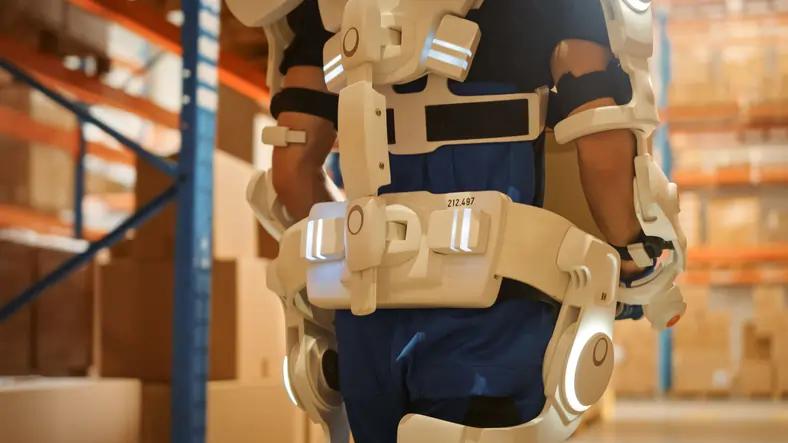Wearable Exoskeleton Market to Soar at 30.5% CAGR, Reaching $6.88 Billion by 2034
Wearable Exoskeleton Market to Soar at 30.5% CAGR, Reaching $6.88 Billion by 2034
Published by Jessica Weisman-Pitts
Posted on March 17, 2025

Published by Jessica Weisman-Pitts
Posted on March 17, 2025

Leading Producers Offering More Advanced Wearable Exoskeletons for Reducing Spinal Cord Strain: Fact.MR Report
Fact.MR, a market research and competitive intelligence provider, through its updated market analysis, reveals that revenue from the wearable exoskeleton market is approximated to reach US$ 480.3 million in 2024 and advance at a double-digit CAGR of 30.5% through 2034.
Wearable exoskeleton demand is anticipated to be sustained due to existing market trends. Prominent manufacturers are creating suitable wearable exoskeletons that help reduce stress on the spinal cord because traumatic wounds account for nearly nine out of ten injuries.
In 2018, scientists at the Universidad Miguel Hernandez in Elche, Spain, created a robotic smart exoskeleton that aids with eating, drinking, and washing people with disabilities when paired with a robotic wheelchair. The forces exerted on an employee's arms and torso by upper extremity exoskeletons are distinct from the forces needed to lift a weight. These are essential human extenders that boost strength to lift hefty, bulky objects.
Key Takeaways from the Market Study
“Wearable exoskeletons are crucial for human extenders that increase power so that large, heavy objects are handled, thus expanding their sales in the market,” says a Fact.MR analyst.
Wearable Exoskeletons Gaining Traction with Rising Incidence of Neurological Conditions Such as Strokes and Spinal Cord Injuries (Scis)
In terms of extremities, powered exoskeletons for the lower limb are gaining popularity for wearing exoskeletons for the lower extremities. Several patients with neuromuscular impairments in their lower limbs are putting pressure on clinicians to provide more long-lasting mobility options. The increasing prevalence of neurological disorders, such as spinal cord injuries (SCIs) and strokes, frequently has a detrimental effect on quality of life. Being able to walk again is therefore one of the key objectives of rehabilitation. It is projected that this segment will account for three-quarters of the global market value.
Wearable Exoskeleton Industry News:
Key players in the wearable exoskeleton industry are heavily investing in research and development (R&D) to introduce innovative products and gain a competitive edge. In addition to product advancements, companies are also focusing on strategic collaborations, mergers and acquisitions, and securing regulatory approvals to drive market growth. These efforts are crucial in expanding the adoption of wearable exoskeletons across various applications, including rehabilitation, industrial support, and military use.
Several notable collaborations have taken place to enhance the accessibility and effectiveness of wearable exoskeletons. In March 2021, ReWalk Robotics signed a contract with BKK Mobil Oil Insurance to supply ReWalk Personal Exoskeleton devices to qualified individuals with spinal cord injuries, allowing them to maintain mobility at home with the ReWalk Personal 6.0 exoskeleton. Similarly, Singapore’s National Healthcare Group (NHG) and Shanghai-based Fourier Intelligence signed a memorandum of understanding in 2021 to co-develop robotic and rehabilitation technologies. This partnership aims to integrate clinical expertise with translational research, improving rehabilitation outcomes for patients through advanced robotic solutions.
Leading Players Driving Innovation in the Wearable Exoskeleton Market:
Key industry participants like EksoBionics; Walkbot (P&S Mechanics Co. Ltd); Lockheed Martin Corporation; RB3D; Fourier Intelligence; AXOSUITS SRL; FREE Bionics Taiwan Inc.; Innophys Co., Ltd.; Medexo Robotics; ReWalkRobotics; Bionik, Inc.; Cyberdyne Inc.; Rex Bionics Ltd.; HocomaAG; Wearable Robotics S.r.L; Noonee; Technaid. etc. are driving the wearable exoskeleton industry.
Get Customization on this Report for Specific Research Solutions: https://www.factmr.com/connectus/sample?flag=S&rep_id=3436More Valuable Insights on Offer
Fact.MR, in its new offering, presents an unbiased analysis of the wearable exoskeletons market for 2019 to 2023 and forecast statistics for 2024 to 2034.
The study divulges the wearable exoskeletons market based on product (rigid smart exoskeletons, soft smart exoskeletons), extremity (lower extremity exoskeletons, upper extremity exoskeletons, full-body extremity exoskeletons), application (rehabilitation, pick & carry), and end user (industrial use, healthcare, military), across seven major regions of the world (North America, Latin America, Western Europe, Eastern Europe, East Asia, South Asia & Pacific, and MEA).
Check out More Related Studies Published by Fact.MR Research:
Exoskeleton robots market is forecasted to skyrocket at an impressive CAGR of 23.7%, rising from its current market valuation of US$ 950 million to US$ 8 billion by the end of 2032.
Military exoskeleton market stands at US$ 1.1 billion in 2023. The industry is projected to expand rapidly at a high-value CAGR of 14.5% and reach US$ 4.27 billion by 2033.
Digital battlefield market is expected to increase from a value of US$ 41.22 billion in 2024 to US$ 142.32 billion by the end of 2034.
Wearable payment device market is analyzed to reach US$ 33.47 billion in 2024. The market is evaluated to reach a value of US$ 133.09 billion by the end of the assessment period in 2034, and expanding at a CAGR of 14.8% from 2024 to 2034.
Walking assist devices market is slated to increase from a valuation of US$ 6.5 billion in 2022 to US$ 7.4 billion by 2027 and expanding at a CAGR of 2.6%.
Explore more articles in the Research Reports category











